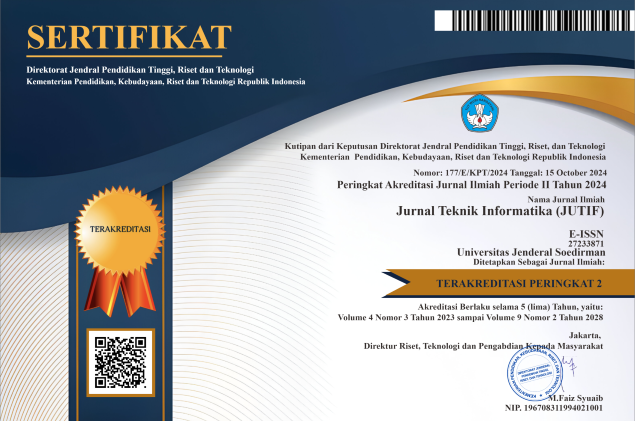PERFORMANCE ANALYSIS OF EXTRACT, TRANSFORM, AND LOAD METHODS FOR BUSINESS INTELLIGENCE IN E-LEARNING SYSTEMS USING PENTAHO DATA INTEGRATION
DOI:
https://doi.org/10.52436/1.jutif.2025.6.1.4173Keywords:
Business Intelligence, Data Warehouse, ETL performance, LMS, Pentaho Data IntegrationAbstract
The rapid adoption of Learning Management Systems (LMS) in higher education has resulted in the generation of large and complex datasets, posing significant challenges for efficient data integration and analysis. The urgency to address these challenges is driven by the growing demand for real-time analytics and data-driven decision-making in educational institutions. This study advances the field of computer science by evaluating and comparing the performance of three Extract, Transform, and Load (ETL) methods—Table Output, Sync After Merge, and Switch Case—using Pentaho Data Integration (PDI). The study introduces novel insights into ETL optimization techniques, focusing on execution time as the primary metric, critical for ensuring timely and reliable insights in Business Intelligence (BI) systems. Performance testing was conducted with synthetic datasets ranging from 150 to 1,000,000 records across five scenarios: data addition, synchronization, insertion, deletion, and combined operations. Results reveal that Sync After Merge outperformed other methods, achieving up to 35% faster execution times, particularly with large datasets. These findings contribute significantly to the advancement of data integration techniques in computer science, enabling institutions to optimize their BI systems, enhance system responsiveness, and support data-driven decision-making processes effectively. The research provides valuable insights for developing scalable ETL solutions in educational technology systems.
Downloads
References
H. D. Surjono, Membangun Course E-Learning Berbasis Moodle, 2nd ed. Yogyakarta: UNY Press, 2013.
J. Cole and H. Foster, Using Moodle: Teaching with the Popular Open Source Course Management System, 2nd ed. O’Reilly Media, 2007.
M. I. Afandi and E. D. Wahyuni, “Data Warehouse Implementation for University Executive Information System with Speech Command Feature,” Apr. 2019, doi: 10.11594/nstp.2019.0222.
L. Dinesh and K. G. Devi, “An efficient hybrid optimization of ETL process in data warehouse of cloud architecture,” Journal of Cloud Computing, vol. 13, no. 1, p. 12, 2024, doi: 10.1186/s13677-023-00571-y.
I. Wilarso, “Pemanfaatan Data Warehouse Di Perguruan Tinggi Indonesia,” Jurnal Sistem Informasi, vol. 4, no. 1, pp. 47–54, 2008, doi: 10.21609/jsi.v4i1.244.
V. Rainardi, Building a data warehouse: With examples in SQL server. 2008. doi: 10.1007/978-1-4302-0528-9.
A. B. Winnetou, S. A. Wicaksono, and A. Pinandito, “Analisis Peningkatan Performa Proses ETL (Extract, Transform, Dan Loading) Pada Data Warehouse Dengan Menerapkan Delta Extraction Menggunakan Historical Table,” Jurnal Pengembangan Teknologi Informasi dan Ilmu Komputer, vol. 2, no. 4, pp. 1366–1371, Aug. 2017.
A. Walha, F. Ghozzi, and F. Gargouri, “Data integration from traditional to big data: main features and comparisons of ETL approaches,” J Supercomput, vol. 80, no. 19, pp. 26687–26725, 2024, doi: 10.1007/s11227-024-06413-1.
W. Fana, R. Sovia, R. Permana, and M. Islam, “Data Warehouse Design With ETL Method (Extract, Transform, And Load) for Company Information Centre,” International Journal of Artificial Intelligence Research, vol. 5, Jan. 2021, doi: 10.29099/ijair.v5i2.215.
O. Baker and C. N. Thien, “A New Approach to Use Big Data Tools to Substitute Unstructured Data Warehouse,” in 2020 IEEE Conference on Big Data and Analytics (ICBDA), 2020, pp. 26–31. doi: 10.1109/ICBDA50157.2020.9289757.
D. Seenivasan, “Improving the Performance of the ETL Jobs,” International Journal of Computer Trends and Technology, vol. 71, pp. 27–33, Jan. 2023, doi: 10.14445/22312803/IJCTT-V71I3P105.
R. Harris, “Data Warehousing and Decision Support System Effectiveness Demonstrated in Service Recovery During COVID19 Health Pandemic,” Jan. 2020, pp. 1–5. doi: 10.1109/ICOSST51357.2020.9333019.
E. M. Haryono, Fahmi, A. S. Tri W, I. Gunawan, A. Nizar Hidayanto, and U. Rahardja, “Comparison of the E-LT vs ETL Method in Data Warehouse Implementation: A Qualitative Study,” in 2020 International Conference on Informatics, Multimedia, Cyber and Information System (ICIMCIS), 2020, pp. 115–120. doi: 10.1109/ICIMCIS51567.2020.9354284.
S. Vučetić, S. Ilić, S. Savić, and S. Ilić, “Comparison of ETL execution speeds when using SQL code and when using SSIS built-in components,” pp. 120–126, Jan. 2023, doi: 10.70456/QMXD2316.
D. Seenivasan, “Exploring Popular ETL Testing Techniques,” International Journal of Computer Trends and Technology, vol. 71, pp. 32–39, Jan. 2023, doi: 10.14445/22312803/IJCTT-V71I2P106.
G. Mhon and N. Kham, “ETL Preprocessing with Multiple Data Sources for Academic Data Analysis,” Jan. 2020, pp. 1–5. doi: 10.1109/ICCA49400.2020.9022824.
H. Qin, X. Jin, and X. Zhang, “Research on Extract, Transform and Load(ETL) in Land and Resources Star Schema Data Warehouse,” 2012 Fifth International Symposium on Computational Intelligence and Design, vol. 1, pp. 120–123, 2012, [Online]. Available: https://api.semanticscholar.org/CorpusID:16045132
R. Nath, O. Romero, T. Pedersen, and K. Hose, “High-level ETL for Semantic Data Warehouses,” Semant Web, vol. 13, pp. 85–132, Jan. 2021, doi: 10.3233/SW-210429.
N. Prasath and J. Sreemathy, “A New Approach for Cloud Data Migration Technique Using Talend ETL Tool,” in 2021 7th International Conference on Advanced Computing and Communication Systems (ICACCS), 2021, pp. 1674–1678. doi: 10.1109/ICACCS51430.2021.9441898.
H. Homayouni, “Testing Extract-Transform-Load Process in Data Warehouse Systems,” in 2018 IEEE International Symposium on Software Reliability Engineering Workshops (ISSREW), 2018, pp. 158–161. doi: 10.1109/ISSREW.2018.000-6.
A. Qaiser, M. Farooq, S. M. N. Mustafa, and N. Abrar, “Comparative Analysis of ETL Tools in Big Data Analytics,” p. 2023, Jan. 2023.
F. Sudarto, D. Aryani, and Y. Yulianto, “Pengembangan Bussiness Intelegence (BI) Untuk Perusahaan Dalam Membangun Solusi Bisnis Berbasis Open Source,” Journal Sensi: Strategic of Education in Information System, vol. 1, no. 1, pp. 1–8, Aug. 2015.
J. Sreemathy, I. Joseph V., S. Nisha, C. Prabha I., and G. Priya R.M., “Data Integration in ETL Using TALEND,” in 2020 6th International Conference on Advanced Computing and Communication Systems (ICACCS), 2020, pp. 1444–1448. doi: 10.1109/ICACCS48705.2020.9074186.
Q. T. Minh, D. T. Thai, B. T. Duc, and N. H. Phat, “Designing a Data Warehouse Framework for Business Intelligence,” in 2022 International Conference on Data Analytics for Business and Industry (ICDABI), 2022, pp. 498–502. doi: 10.1109/ICDABI56818.2022.10041706.
B. Khan, S. Jan, and W. Khan, “An Overview of ETL Techniques, Tools, Processes and Evaluations in Data Warehousing,” Journal on Big Data, vol. 6, pp. 1–20, Jan. 2024, doi: 10.32604/jbd.2023.046223.


























